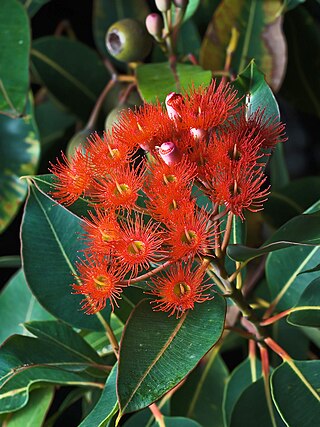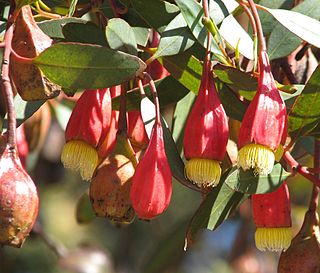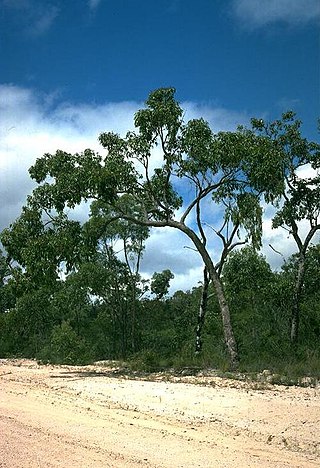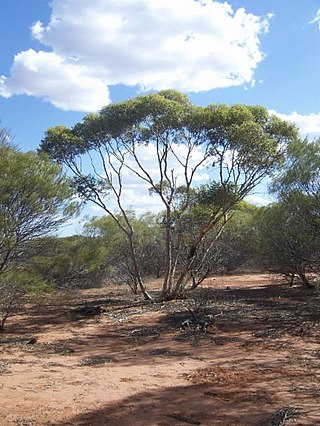
Corymbia ficifolia, commonly known as red flowering gum, is a species of small tree that is endemic to the south-west of Western Australia. It has rough, fibrous bark on the trunk and branches, egg-shaped to broadly lance-shape adult leaves, flower buds in groups of seven, bright red, pink or orange flowers and urn-shaped fruit. It has a restricted distribution in the wild but is one of the most commonly planted ornamental eucalypts.

Eucalyptus microcorys, commonly known as tallowwood, is a species of medium to tall tree that is endemic to eastern Australia. It has rough, fibrous or string bark on the trunk and branches, lance-shaped to egg-shaped adult leaves, flower buds in groups of seven or nine, white to lemon-yellow flowers and conical fruit. It grows in forests near the coast of Queensland and New South Wales.

Eucalyptus eremophila, commonly known as the sand mallet or tall sand mallee, is a species of mallet that is endemic to semi-arid regions of Western Australia. It has smooth pale brown and greyish bark, narrow lance-shaped to elliptical adult leaves, flower buds arranged in groups of between seven and eleven with an elongated operculum, and cup-shaped to barrel-shaped fruit.

Eucalyptus erythrocorys, commonly known as illyarrie, red-capped gum or helmet nut gum, is a species of tree or mallee from Western Australia. It has smooth bark, sickle-shaped to curved adult leaves, characteristically large flower buds in groups of three with a bright red operculum, bright yellow to yellowish green flowers and sculptured, bell-shaped fruit.

Eucalyptus forrestiana, commonly known as fuchsia gum or fuchsia mallee, is a species of small tree or mallet and is endemic to an area near Esperance, Western Australia. It has smooth grey bark, narrow oblong to lance-shaped adult leaves, flower buds that are square in cross-section, red at maturity and arranged singly in leaf axils, yellow flowers and four-angled, winged fruit.

Eucalyptus cloeziana, commonly known as Gympie messmate or dead finish, is a species of tree that is endemic to Queensland. It has rough, flaky to fibrous bark on its trunk, smooth bark above, lance-shaped to curved adult leaves that are much paler on the lower side, flower buds in groups of seven, white flowers and hemispherical fruit.

Corymbia abergiana, commonly known as range bloodwood or Rockingham Bay bloodwood, is a species of tree that is endemic to Queensland. It has rough bark on the trunk and larger branches, smooth bark on the smaller branches, lance-shaped adult leaves, flower buds in groups of seven, creamy white flowers and barrel-shaped fruit with a very thick rim.

Eucalyptus megacarpa, commonly known by its Noongar name of bullich, is a species of robust mallee or small to medium-sized tree with a scattered distribution in the forests of the south-west of Western Australia. It has smooth bark throughout, lance-shaped to curved adult leaves, flower buds in groups of three, white flowers and cup-shaped, bell-shaped or hemispherical fruit.

Eucalyptus eudesmioides, commonly known as mallalie, desert gum or mallabie is a species of mallee that is endemic to Western Australia. It is a rounded, bushy mallee with smooth bark, egg-shaped to heart-shaped leaves arranged in opposite pairs, club-shaped flower buds arranged in groups of three, whitish flowers and cylindrical to barrel-shaped fruit.

Eucalyptus luehmanniana, commonly known as the yellow top mallee ash, is a species of mallee that is endemic to a small area in New South Wales. It has smooth white bark, lance-shaped to curved adult leaves, flower buds in groups of between seven and eleven or more, white flowers and cup-shaped, urn-shaped or barrel-shaped fruit. It has a restricted distribution on poor, rocky soils near Sydney.

Eucalyptus pellita, commonly known as the large-fruited red mahogany, is a species of medium to tall tree that is endemic to north-eastern Queensland. It has rough, fibrous or flaky bark on the trunk and branches, lance-shaped to egg-shaped adult leaves, flower buds in groups of seven, white flowers and cup-shaped to conical fruit.

Eucalyptus planchoniana, commonly known as the needlebark stringybark or bastard tallowwood is a species of small to medium-sized tree that is endemic to eastern Australia. It has rough, stringy bark on the trunk and larger branches, lance-shaped to curved adult leaves, flower buds in groups of seven, white flowers and cup-shaped, cylindrical or barrel-shaped fruit.

Eucalyptus cooperiana, commonly known as the many-flowered mallee, is a species of mallee that is endemic to an area along the south coast of Western Australia. It is described as being "of striking appearance by reason of its smooth, white bark and acutely angled branchlets". It has lance-shaped adult leaves, flower buds in groups of between nine and thirteen or more, creamy yellow flowers and urn-shaped fruit.

Eucalyptus gamophylla, commonly known as warilu, blue-leaved mallee, twin-leaf mallee, twin-leaved mallee or blue mallee, is a species of mallee that is native to Western Australia, South Australia and the Northern Territory. It usually has smooth bark, mostly only juvenile leaves arranged in opposite pairs, flower buds in groups of three, whitish flowers and cylindrical to barrel-shaped fruit that is four-sided in cross-section.

Eucalyptus oldfieldii, commonly known as Oldfield's mallee, is a species of mallee or tree that is endemic to Western Australia. It has a sprawling or spreading habit, mostly smooth greyish or brownish bark, lance-shaped adult leaves, flower buds in groups of three, white flowers and conical, cup-shaped or hemispherical fruit.

Eucalyptus rameliana, commonly known as Ramel's mallee, is a species of low growing mallee that is endemic to desert areas of central Western Australia. It has smooth bark, broadly lance-shaped to egg-shaped adult leaves, flower buds arranged singly in leaf axils, pale yellow flowers and flattened, pyramid-shaped fruit.

Corymbia watsoniana, commonly known as large-fruited yellowjacket, is a species of tree that is endemic to Queensland. It has rough, tessellated bark on the trunk and branches, egg-shaped to broadly lance-shaped adult leaves, flower buds in groups of seven, creamy white flowers and barrel-shaped or urn-shaped fruit.

Eucalyptus buprestium, also known as the apple mallee or ball-fruited mallee, is a small mallee that is endemic to an area along the south coast of Western Australia. It has smooth bark, narrow lance-shaped adult leaves, flower buds arranged in groups of between nine and fifteen, white flowers and almost spherical fruit with a small opening.

Eucalyptus decurva, commonly known as the slender mallee, is a species of mallee that is endemic to the south-west of Western Australia. It has smooth whitish bark, lance-shaped to curved adult leaves, pendulous flower buds arranged in groups of seven, white flowers and pendulous, more or less spherical fruit.

Eucalyptus doratoxylon, commonly known as the spearwood mallee, spearwood or geitch-gmunt in Noongar language is a species of mallee that is endemic to Western Australia. It has smooth, powdery white bark, lance-shaped to curved adult leaves mostly arranged in opposite pairs, flower buds in groups of seven, white to pale yellow flowers and pendulous, more or less spherical fruit.























